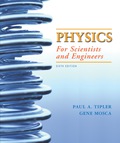
Concept explainers
Radius of the asteroid.
Answer to Problem 19P
Near about
Explanation of Solution
Introduction:
The escape velocity on the surface of the asteroid is
Here,
Relation among mass, density and volume is ,
The second
The escape velocity on the surface of the asteroid is
From the equation
The radius of the Asteroid is given by
From the kinematic equation of motion,
Here ‘h’ is the height to which you can jump on the surface of the Earth.
As finally come to rest, the final speed of you is
Therefore
Let
Therefore, the radius of the asteroid
Asssume that you can jump a height
Density of the asteroid is
Universal gravitational constant is
By substituting all known values in the equation
Radius of the asteroid is
Conclusion:
Radius of asteroid is
Want to see more full solutions like this?
Chapter 11 Solutions
EBK PHYSICS FOR SCIENTISTS AND ENGINEER
- Check Your Understanding By what factor must the radius change to reduce the orbital velocity of a satellite by one-half? By what factor would this change the period?arrow_forwardFollowing the technique used in Gravitation Near Earth’s Surface, find the value of g as a function of the radius r from the center of a spherical shell planet of constant density with inner and outer radii Rin and Rout . Find g for both eq and for RinrRout . Assuming the inside of the shell is kept airless, describe travel inside the spherical shell planet.arrow_forwardCheck Your Understanding The nearly circular orbit of Saturn has an average radius of about 9.5 AU and has a period of 30 years, whereas Uranus averages about 19 AU and has a period of 84 years. Is this consistent with our results for Halley’s comet?arrow_forward
- A Molniya orbit is a highly eccentric orbit of a communication satellite so as to provide continuous communications coverage for Scandinavian countries and adjacent Russia. The orbit is positioned so that these countries have the satellite in view for extended periods in time (see below). If a satellite in such an orbit has an apogee at 40,000.0 km as measured from the center of Earth and a velocity of 3.0 km/s, what would be its velocity at perigee measured at 200.0 km altitude?arrow_forwardUsing Figure 13.9, carefull sketch a free body diagram for the case of a simple pendulum hanging at latitude lambda, labeling all forces acting on the point mass,m. Set up the equations of motion for equilibrium, setting one coordinate in the direction of the centripetal accleration (toward P in the diagram), the other perpendicular to that. Show that the deflection angle , defined as the angle between the pendulum string and the radial direction toward the center of Earth, is given by the expression below. What is the deflection angle at latitude 45 degrees? Assume that Earth is a perfect sphere. tan(+)=gg2REtan , where is the angular velocity of Earth.arrow_forwardA point mass m is located a distance D from the nearest end of a thin rod of mass M and length L along the axis of the rod. Find the gravitational force exerted on the point mass by the rod.arrow_forward
- Check Your Understanding Galaxies are not single objects. How does the gravitiational force of one galaxy exerted on the “closer” stars of the other galaxy compare to those farther away? What effect would this have on the shape of the galaxies themselves?arrow_forwardUsing the technique shown in Satellite Orbits and Energy, show that two masses m1 and m2 in circular orbits about their common center of mass, will have total energy E=K+E=K1+K2Gm1m2r=Gm1m22r . We have shown the kinetic energy of both masses explicitly. (Hint: The masses orbit at radii r1 and r2 , respectively, where r=r1+r2 . Be sure not to confuse the radius needed for centripetal acceleration with that for the gravitational force.)arrow_forwardIn the blockbuster hit Gravity, Sandra Bullock and George Clooney are in a shuttle that is going through a debris field every 90 mins. The only way this could happen is if some of the debris was moving in the same orbit as the shuttle but in the opposite direction, as schematically shown in the figure to the right. Assume the orbits are perfectly circular for simplicity, and use the fact that the mass and radius of the earth are = 5.973 X 10^24 kg and R = 6.370 X 10^3 km, respectively. (a) What is the altitude of the orbit of the two pseudo-astronauts? (b) What speed are George and Sandra moving at? (c) Say Sandra?s mass (with spacesuit and all) is 85 kg. What is her total energy in this orbit?arrow_forward
 University Physics Volume 1PhysicsISBN:9781938168277Author:William Moebs, Samuel J. Ling, Jeff SannyPublisher:OpenStax - Rice University
University Physics Volume 1PhysicsISBN:9781938168277Author:William Moebs, Samuel J. Ling, Jeff SannyPublisher:OpenStax - Rice University Classical Dynamics of Particles and SystemsPhysicsISBN:9780534408961Author:Stephen T. Thornton, Jerry B. MarionPublisher:Cengage Learning
Classical Dynamics of Particles and SystemsPhysicsISBN:9780534408961Author:Stephen T. Thornton, Jerry B. MarionPublisher:Cengage Learning Glencoe Physics: Principles and Problems, Student...PhysicsISBN:9780078807213Author:Paul W. ZitzewitzPublisher:Glencoe/McGraw-Hill
Glencoe Physics: Principles and Problems, Student...PhysicsISBN:9780078807213Author:Paul W. ZitzewitzPublisher:Glencoe/McGraw-Hill Stars and Galaxies (MindTap Course List)PhysicsISBN:9781337399944Author:Michael A. SeedsPublisher:Cengage Learning
Stars and Galaxies (MindTap Course List)PhysicsISBN:9781337399944Author:Michael A. SeedsPublisher:Cengage Learning
 Foundations of Astronomy (MindTap Course List)PhysicsISBN:9781337399920Author:Michael A. Seeds, Dana BackmanPublisher:Cengage Learning
Foundations of Astronomy (MindTap Course List)PhysicsISBN:9781337399920Author:Michael A. Seeds, Dana BackmanPublisher:Cengage Learning





